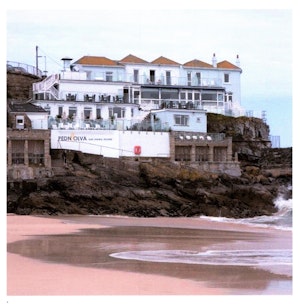“Greniar [Greniar [Graniers], St Tropez, Southern France [BC024]] offers evidence of Scales’ increasing independence, which would strengthen further following the war. From the mid-1940s, her imagery became softer still and her paint application thinned to the extreme. Initially, in works like Port of Weymouth Bay [BC025] (1945) and Untitled [Mousehole, Cornwall 2] [BC029] (ca. 1950-59), she built scenes around a contrast between canted three-dimensional motifs, like boats and buildings, and a hazy, often gold-tinged environment. Once complete, these compositions appeared to have been painted in two registers: the first flat and the second volumetric.
As time wore on, however, this spatial disjunction disappeared, and by the early 1960s, the buildings that still featured in her landscapes had become as indistinct as their surroundings. Emblematic of this shift are Bry-sur-Marne Looking Towards the Marne Valley [BC045] (1965) and Untitled [Pedn-Olva Hotel] [BC063] (ca. 1966-69). Evidently there are structures nestled at the heart of both scenes, but in the former, their presence is disclosed by just a few white and terracotta dabs. In the latter, which Scales left untitled, it is only the work’s resemblance to named paintings like Boarding House, St Ives, Cornwall [1] [BC060] (1968-1970) that allows us to discern a hotel. Even then we may have doubts about its shape and construction.
In works such as these, Scales drew upon her decades of experience to develop her own radical approach to Impressionism. Setting Cézanne’s pursuit of solidity aside, but retaining and adapting his patch-work approach to composition, she returned to her Impressionist roots. Yet rather than revive her orthodox Impressionist technique of the 1910s and 1920s, she intensified the style’s dissolution of its subjects into light."

-1639295706.jpg?ixlib=js-3.8.0&auto=format&w=300)